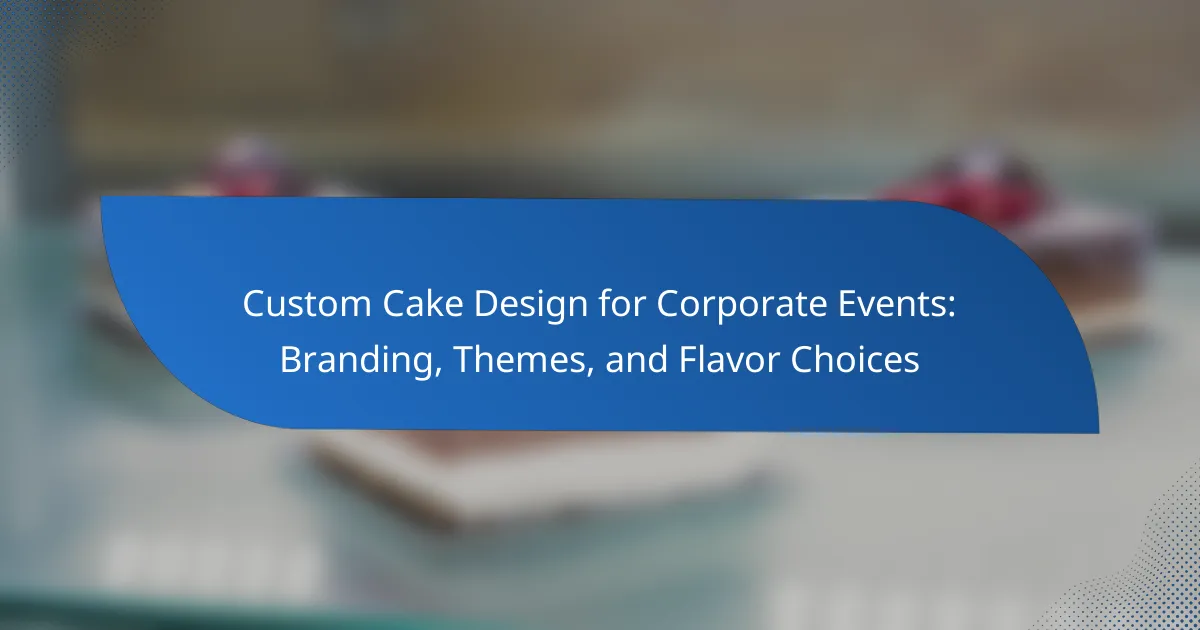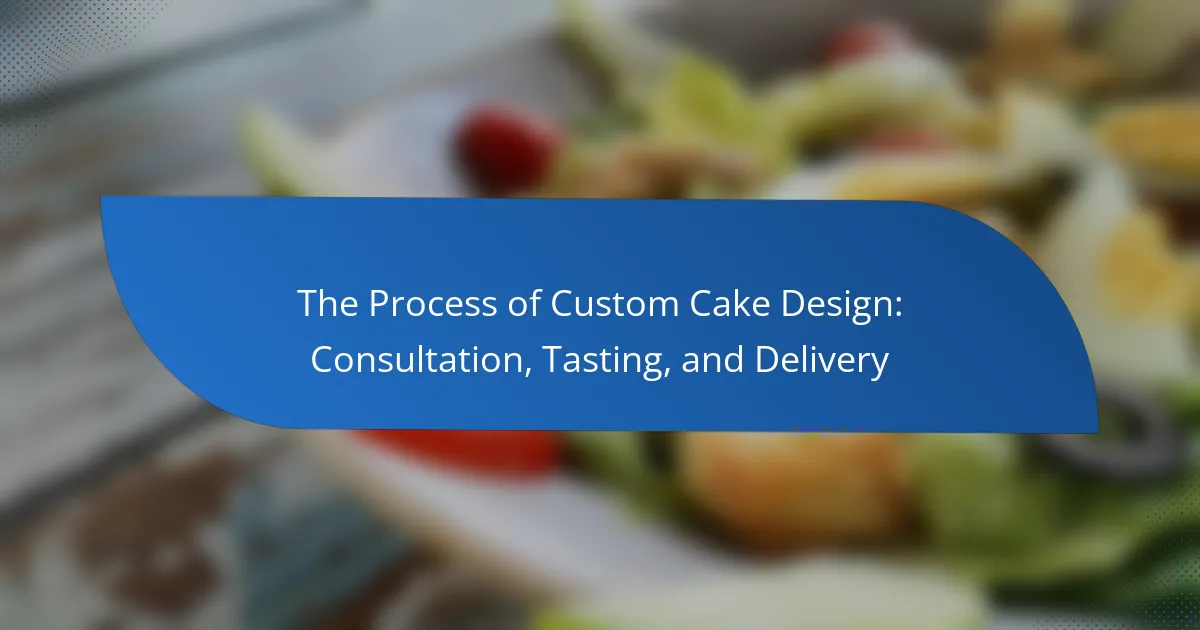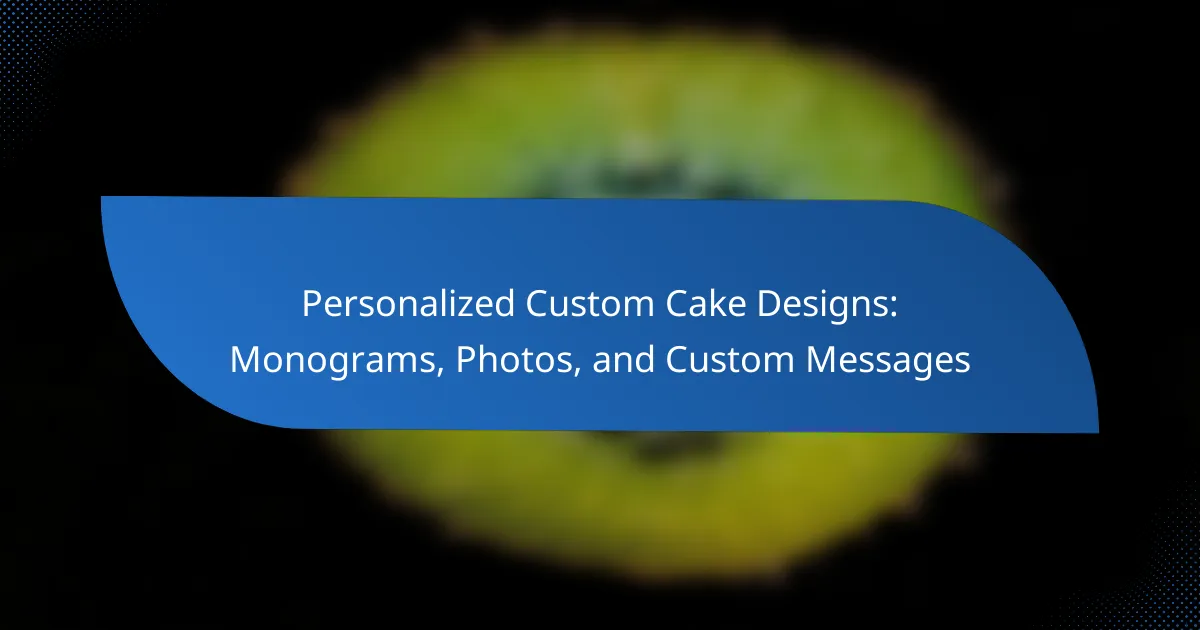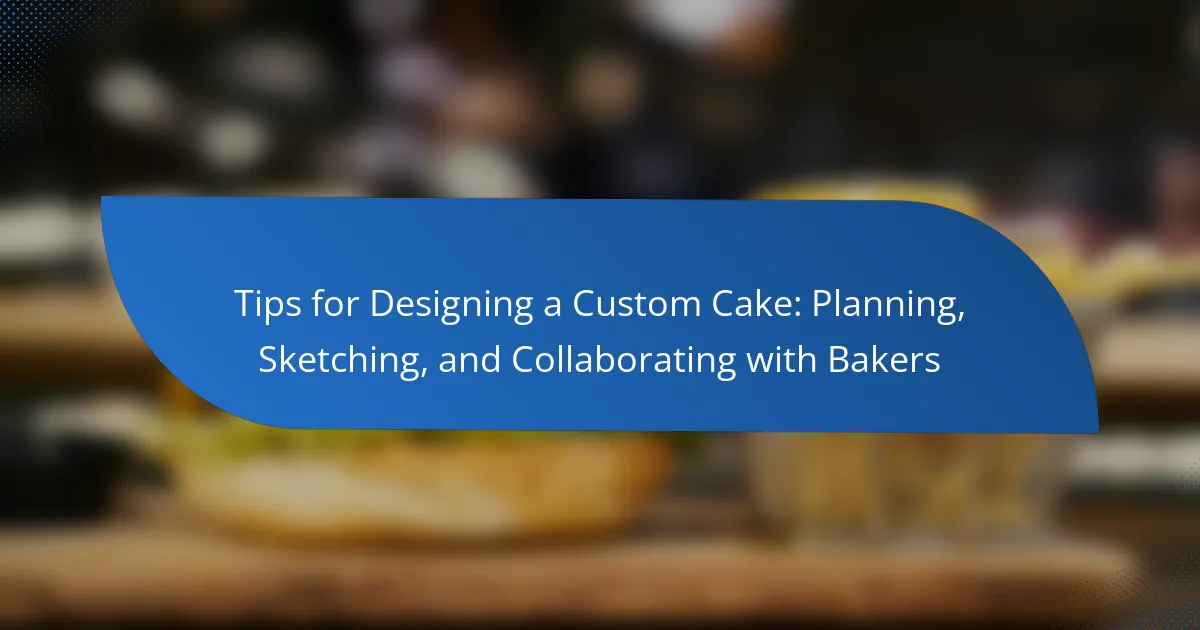Custom cake design refers to the creation of unique, personalized cakes that are tailored to specific themes or occasions, utilizing artistic techniques and skilled craftsmanship. This process involves selecting flavors, colors, and decorations that reflect client preferences, particularly for events such as weddings, birthdays, and corporate gatherings. The article explores various inspirations for custom cake design, including nature, cultural influences, and personal interests, while emphasizing best practices such as effective client communication, quality ingredient selection, and essential baking techniques. Additionally, it highlights the importance of staying updated on trends to offer innovative designs that blend aesthetics with flavor.
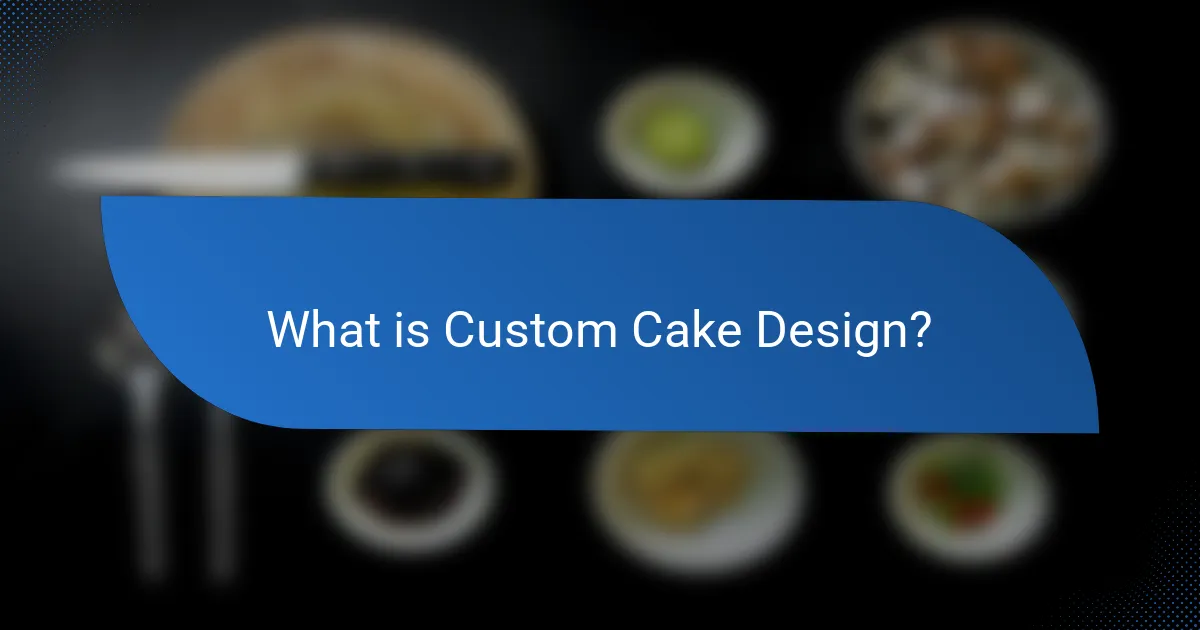
What is Custom Cake Design?
Custom cake design is the creation of unique, personalized cakes tailored to specific themes or occasions. This process involves artistic techniques, skilled craftsmanship, and a variety of materials. Custom cakes can incorporate specific flavors, colors, and decorations that reflect the client’s preferences. Popular occasions for custom cakes include weddings, birthdays, and corporate events. The design may include intricate fondant work, edible images, or hand-painted elements. Each cake is crafted to meet individual specifications, ensuring it stands out. Custom cake design has gained popularity due to its ability to blend aesthetics with flavor.
How does Custom Cake Design differ from traditional cake baking?
Custom cake design focuses on creating unique, artistic cakes tailored to specific themes or events. Traditional cake baking typically involves standard recipes and designs that are widely used. Custom cake designers often use advanced techniques such as fondant sculpting and intricate piping to achieve detailed aesthetics. In contrast, traditional baking emphasizes taste and texture, often prioritizing classic flavors and simple decorations. Custom designs may incorporate non-traditional materials like edible prints and 3D elements. Traditional cakes usually rely on basic ingredients and methods familiar to most bakers. The customization aspect allows for personalization that traditional baking generally does not offer. This distinction highlights the creative expression found in custom cake design compared to the conventional approach of traditional baking.
What unique elements define Custom Cake Design?
Custom cake design is defined by its personalization, creativity, and intricate detailing. Each cake is tailored to meet specific client preferences, including themes and flavors. Unique elements often include custom shapes, colors, and decorations that reflect the occasion. High-quality ingredients are frequently used to enhance taste and presentation. Techniques such as fondant work, sugar sculpting, and airbrushing are common. Custom cake designs may also incorporate edible images or handcrafted toppers. These elements collectively elevate the cake from a standard dessert to a work of art. Custom cake design is often showcased in competitions, highlighting the skill and artistry involved.
Why is personalization important in Custom Cake Design?
Personalization is important in custom cake design because it creates a unique experience for the customer. Personalized cakes reflect individual preferences and themes. This enhances emotional connections to the celebration. Custom designs can incorporate specific colors, flavors, and messages. According to a survey by The Knot, 70% of couples prefer personalized wedding cakes. Personalization also allows for creative expression, making each cake a work of art. Tailored designs can cater to dietary restrictions or preferences. Overall, personalization elevates the significance of the occasion being celebrated.
What are the key techniques in Custom Cake Design?
The key techniques in custom cake design include fondant application, buttercream piping, and cake sculpting. Fondant application involves rolling out the fondant to cover the cake smoothly. This technique allows for intricate designs and a polished finish. Buttercream piping is used to create decorative borders and flowers. This technique enhances the visual appeal of the cake with various textures. Cake sculpting allows bakers to create three-dimensional designs. This technique requires skill in carving and shaping the cake to achieve desired forms. Additionally, airbrushing adds color and depth to cake surfaces. Each technique contributes to the overall artistry in custom cake design.
How can decorators achieve intricate designs?
Decorators can achieve intricate designs by utilizing various techniques and tools. Techniques such as piping, fondant sculpting, and airbrushing allow for detailed patterns. Piping involves using a pastry bag to create intricate designs with icing. Fondant can be molded into shapes, providing versatility in design. Airbrushing adds depth and color gradients, enhancing visual appeal.
Tools such as stencils and molds assist in achieving precision. Stencils help create consistent patterns on cake surfaces. Molds allow decorators to replicate complex shapes easily. Additionally, decorators often use edible paints for fine detailing.
The combination of these methods enables decorators to produce visually stunning cakes. According to a study by the Culinary Institute of America, mastery of these techniques significantly improves design complexity.
What role does cake sculpting play in Custom Cake Design?
Cake sculpting is essential in custom cake design. It allows bakers to create three-dimensional shapes and intricate designs. This technique enhances the visual appeal of the cake. Sculpting transforms a standard cake into a personalized masterpiece. It involves carving and shaping cake layers into specific forms. Artists use various tools to achieve precise details. The skill level in sculpting directly impacts the cake’s uniqueness. Successful cake sculpting requires both creativity and technical expertise.
What materials are essential for Custom Cake Design?
Essential materials for custom cake design include cake layers, frosting, and fondant. Cake layers serve as the base structure. Frosting provides flavor and a smooth finish. Fondant allows for intricate decorations and shapes. Additionally, edible colors and food-safe tools enhance the design process. Baking pans and measuring tools are crucial for precision. Finally, decorative elements like edible glitter and sprinkles add visual appeal. These materials collectively enable the creation of unique and personalized cake designs.
Which types of cake bases are commonly used?
Common types of cake bases include sponge, butter, and pound cakes. Sponge cake is light and airy, made with whipped eggs and sugar. Butter cake is denser, using creamed butter and sugar for richness. Pound cake is traditionally made with equal weights of flour, butter, sugar, and eggs, resulting in a dense texture. Additionally, chiffon and genoise cakes are also popular. Chiffon cake combines oil and eggs for moisture, while genoise relies on whipped eggs for its structure. These bases serve as foundational elements in various cake designs.
What icing and fondant options are available for decoration?
Icing options for decoration include buttercream, royal icing, and ganache. Buttercream is versatile and can be flavored and colored easily. Royal icing is ideal for intricate designs and hardens when dried. Ganache provides a rich chocolate finish and can be poured or spread.
Fondant options consist of rolled fondant, modeling chocolate, and marshmallow fondant. Rolled fondant creates a smooth surface for cakes and can be tinted. Modeling chocolate allows for sculpting and detailed decorations. Marshmallow fondant is a homemade alternative that is soft and pliable.
These icing and fondant types are widely used in cake decorating. Their unique properties cater to different design needs and preferences.
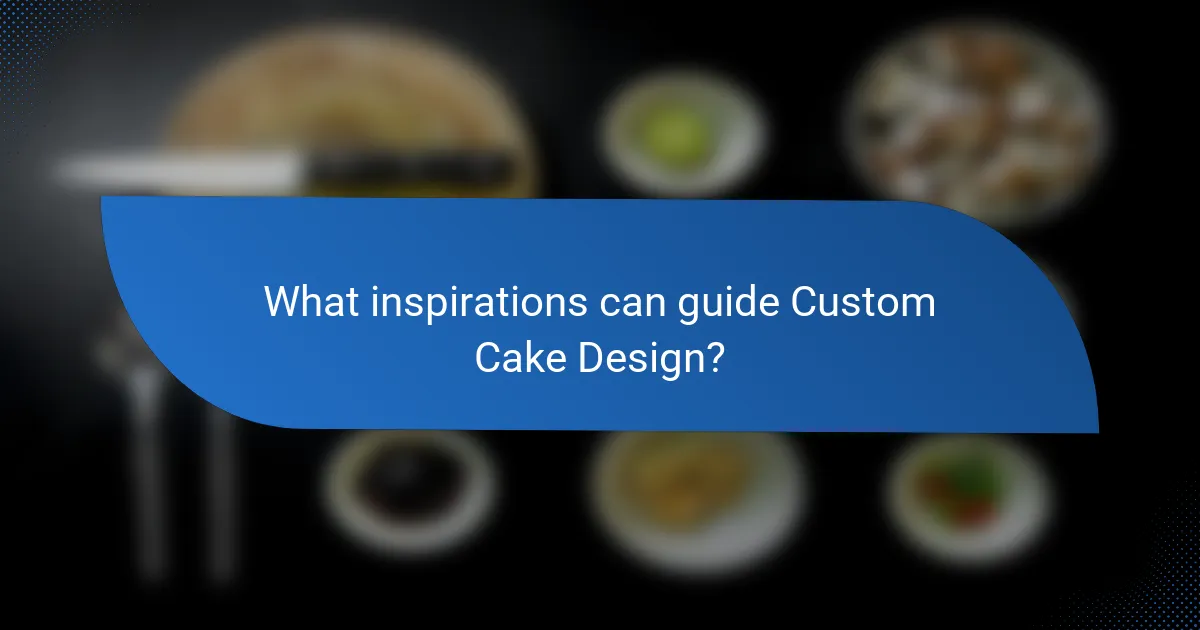
What inspirations can guide Custom Cake Design?
Custom cake design can be inspired by various themes and elements. Popular inspirations include nature, such as floral patterns and landscapes. Cultural influences, like traditional motifs and colors, also play a significant role. Events, including weddings and birthdays, often dictate design choices. Personal interests, such as hobbies or favorite colors, can guide customization. Additionally, artistic styles, like vintage or modern aesthetics, provide a creative framework. Food trends, such as flavors and textures, inspire innovative designs. These inspirations help create unique and personalized cakes tailored to individual preferences.
How can themes influence Custom Cake Design?
Themes significantly influence custom cake design by providing a framework for creativity and direction. They guide the choice of colors, shapes, and decorations. For example, a floral theme may lead to pastel colors and delicate sugar flowers. Conversely, a rustic theme may inspire the use of natural elements like wood textures and earth tones. Themes also dictate the overall style of the cake, such as elegant, whimsical, or modern. This alignment ensures that the cake resonates with the occasion it celebrates. Research shows that themed cakes enhance the visual appeal and overall experience of events, making them memorable for guests.
What are popular themes for Custom Cakes?
Popular themes for custom cakes include birthdays, weddings, and baby showers. Birthday cakes often feature vibrant colors and personalized designs. Wedding cakes commonly showcase elegant tiers and floral decorations. Baby shower cakes typically highlight pastel colors and cute motifs. Other themes include seasonal celebrations, holidays, and character-themed designs. Each theme can be customized to reflect personal tastes and preferences. The versatility in themes allows for creative expression in cake design.
How can seasonal trends impact cake design choices?
Seasonal trends significantly influence cake design choices. During spring, pastel colors and floral decorations are popular. Summer often sees bright, vibrant colors and tropical themes. In autumn, warm hues and harvest motifs become prevalent. Winter typically favors rich colors and festive designs. Seasonal ingredients also play a role, such as pumpkin in fall or berries in summer. These trends reflect consumer preferences and seasonal celebrations. Designers adapt their styles to align with these trends for market relevance. This alignment ensures cakes appeal to current tastes and occasions.
What resources can help spark creativity in Custom Cake Design?
Online platforms like Pinterest and Instagram provide a wealth of visual inspiration for custom cake design. These platforms feature countless images of innovative cake styles and techniques. Books on cake design, such as “The Cake Bible” by Rose Levy Beranbaum, offer foundational knowledge and advanced techniques. Tutorials on YouTube demonstrate specific skills like fondant application and intricate decorating methods. Local cake decorating classes can also foster creativity through hands-on experience and peer interaction. Additionally, attending cake shows and competitions showcases current trends and unique designs. These resources collectively enhance creativity in custom cake design by providing diverse ideas and practical skills.
Where can one find design inspiration online?
One can find design inspiration online through various platforms. Websites like Pinterest offer a vast collection of images and ideas. Behance showcases professional portfolios from designers worldwide. Instagram features visual content from countless cake designers. Design blogs often highlight trends and unique creations. Additionally, YouTube provides tutorials and showcases innovative techniques. These sources collectively inspire creativity and provide diverse perspectives on cake design.
How can cake design books enhance skills and creativity?
Cake design books enhance skills and creativity by providing structured techniques and visual inspiration. They offer step-by-step instructions on various decorating methods. This guidance helps beginners develop foundational skills. Advanced decorators can refine their techniques through detailed tutorials.
Cake design books also showcase diverse styles and trends. Exposure to different aesthetics stimulates creative thinking. Readers can experiment with new ideas and personalize their designs. Many books include tips on color theory and composition. Understanding these concepts further enhances creative expression.
Statistics show that hands-on practice combined with instructional materials leads to skill improvement. According to a study by the American Culinary Federation, visual learning significantly boosts retention in culinary skills. Therefore, cake design books serve as valuable resources for skill enhancement and creativity in cake decorating.
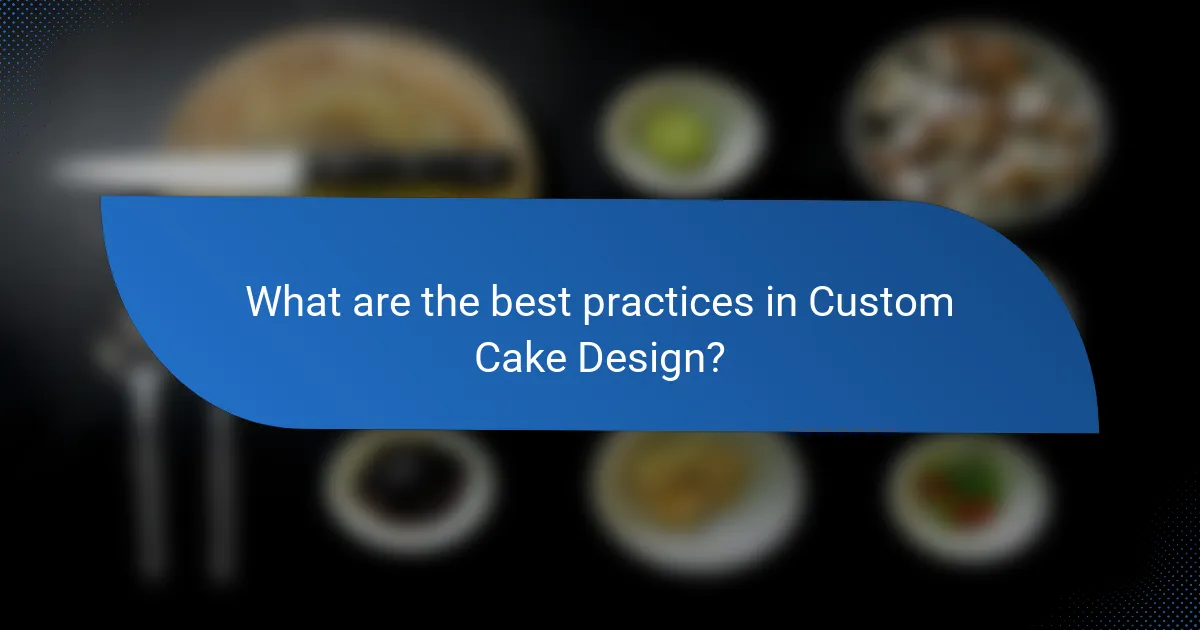
What are the best practices in Custom Cake Design?
The best practices in custom cake design include understanding client preferences, selecting quality ingredients, and mastering essential techniques. Effective communication with clients ensures the design aligns with their vision. Quality ingredients enhance flavor and texture, which are crucial for overall satisfaction. Techniques such as proper baking, leveling, and decorating are fundamental for a polished final product. Utilizing a variety of tools and materials can create unique designs and textures. Staying updated on trends and techniques helps in offering innovative designs. Finally, practicing time management ensures timely delivery without sacrificing quality.
How can one ensure the quality of a Custom Cake?
To ensure the quality of a custom cake, select a skilled baker with relevant experience. Research their portfolio to assess their design and flavor capabilities. Communicate your specific requirements clearly, including flavors, designs, and dietary restrictions. Use high-quality ingredients, as they significantly impact taste and texture. Request tastings to evaluate the flavor profile before finalizing the order. Confirm that the cake is baked fresh and not pre-made. Discuss delivery options to prevent damage during transport. Lastly, check reviews and testimonials to gauge customer satisfaction and consistency in quality.
What are common mistakes to avoid in Custom Cake Design?
Common mistakes to avoid in custom cake design include poor planning and inadequate communication with clients. Failing to understand client preferences can lead to unsatisfactory designs. Not sketching designs beforehand may result in unexpected outcomes. Ignoring the importance of structural integrity can cause cakes to collapse. Using low-quality ingredients affects taste and appearance. Neglecting to account for serving sizes can lead to insufficient portions. Overcomplicating designs can make execution difficult and time-consuming. Lastly, not allowing enough time for decoration can result in rushed, subpar work.
How can bakers maintain consistency in their designs?
Bakers can maintain consistency in their designs by using standardized recipes and techniques. Consistent measurements ensure uniformity in ingredients, which affects texture and taste. Additionally, bakers should utilize templates or stencils for decorative elements. This approach allows for precise replication of designs. Employing the same tools and equipment also contributes to uniform results. Training staff in specific techniques ensures everyone follows the same methods. Regular practice helps bakers refine their skills over time. By implementing these strategies, bakers can achieve a cohesive look across their creations.
What tips can enhance the Custom Cake Design process?
To enhance the Custom Cake Design process, start by gathering inspiration from various sources. Look at trends in cake design, color palettes, and themes. Create a mood board to visualize your ideas and concepts. Plan the design by sketching out the cake layers and decorations. Choose high-quality ingredients to ensure flavor and texture. Invest time in mastering techniques like fondant work and piping. Practice regularly to refine your skills and techniques. Collaborate with clients to understand their vision and preferences. Keep abreast of new tools and technologies in cake design for innovative results.
How can effective planning improve the design outcome?
Effective planning enhances the design outcome by establishing clear objectives and guidelines. It allows designers to visualize the final product before execution. This foresight minimizes errors and reduces wasted resources. A well-structured plan includes timelines, budgets, and material lists. Research shows that projects with detailed planning are 30% more likely to succeed. In custom cake design, this means better alignment with client expectations. Effective planning also facilitates communication among team members. Overall, it leads to more innovative and cohesive designs.
What are essential tools every custom cake designer should have?
Essential tools every custom cake designer should have include cake pans, spatulas, and decorating bags. Cake pans come in various shapes and sizes, allowing for diverse cake designs. Spatulas are crucial for spreading frosting smoothly on cake surfaces. Decorating bags enable intricate designs and precise icing application. A turntable provides a rotating surface for even decoration. A cake leveler ensures uniform cake layers. Fondant tools assist in shaping and detailing fondant decorations. Lastly, a kitchen scale ensures accurate ingredient measurements for consistent results. These tools are fundamental for producing high-quality custom cakes.
The main entity of the article is custom cake design, which involves creating unique, personalized cakes tailored to specific themes or occasions. The article covers various aspects of custom cake design, including the techniques used such as fondant application and cake sculpting, essential materials like cake layers and frosting, and the importance of personalization in enhancing client experiences. It also explores popular themes and seasonal trends that influence design choices, provides resources for inspiration, and outlines best practices for ensuring quality and consistency in custom cake creations.
